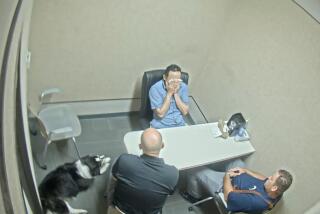Teacher Continues Remarkable Recovery
- Share via
He was not supposed to live. He was not supposed to laugh. He was not supposed to be holding a news conference.
But teacher Alfredo Perez, struck in the brain by a stray bullet in full view of his fifth-graders last winter, did all of the above Tuesday at Martin Luther King Jr./Drew Medical Center.
In his first public comments since the Feb. 22 incident in South-Central Los Angeles, a smiling Perez said in a strong, clear voice from a wheelchair: “I want to thank all of you for your support and prayers.”
Perez can walk with the aid of a cane. His speech is good--in English, Spanish and French--doctors say. One side of his body, the right, is working normally.
To prove that, Perez and Dr. George L. Locke, chairman of King/Drew’s department of neurosciences, gave each other an enthusiastic high five.
Perez, 30, who had been in a residential rehabilitation facility for several months, returned to King/Drew late last week for a procedure that replaced the part of his skull that was blown away by the bullet.
The wounding of Perez at Figueroa Elementary School’s library was both the most serious recorded assault on an L.A. public school teacher and a fearful symbol of the ravenous reach of random violence.
The bullet that hit Perez was allegedly fired by a teenage gang member who was aiming at a passing car of rivals across Figueroa Street. (Two suspects are now facing charges.) It struck Perez on the left side of his forehead, just above the eyebrow, crossing over to the right side of the brain, causing extensive damage leading to disability on the left side of his body.
Only a fortunate series of logistic coincidences and quick work by emergency services personnel and King/Drew’s doctors saved his life. Physicians were grim about how much mental and physical skill he might recover.
Which was why some doctors at King/Drew were using the word “miracle” Tuesday.
“It would have been asking too much for this to happen, for him to be speaking this well,” said Dr. Taghi Tirgari, the surgeon who performed the three-hour emergency operation.
Perez came to the public hospital for last week’s procedure because of insufficient insurance benefits, said Dr. Rosalinda M. Menoni, director of neurosurgery inpatient services.
On Tuesday, Virginia Perez, also a teacher, permitted her husband to answer only a few questions, referring the rest to herself and Locke. Virginia Perez has declined most interviews since the shooting, saying that she is writing a book about her husband’s ordeal.
“We are concerned all this attention might confuse him,” Locke said.
Doctors acknowledge that while they expect Perez to continue to improve, he has a long way to go. His left side is still extremely weak.
“I would say his left arm is like Bob Dole’s right arm, almost useless,” Tirgari said.
He is easily confused and has frequent short-term memory lapses. “Sometimes he cannot remember something that he did 10 minutes ago,” Virginia Perez said.
A brain trauma expert said that while gunshot victims are more likely to die immediately of their wounds than are victims of severe blunt traumas, they often recover more neurological function in the long run.
“If they make it through the acute phase, they generally end up doing better because they have a more focused injury,” said Dr. Nathan Zasler, executive medical director of the National NeuroRehabilitation Consortium in Richmond, Va.
His head bandaged from Friday’s operation, Perez was wheeled into a press room before cameramen, reporters and hospital staff--many of the same people who had gathered in March, when Perez was transferred from King/Drew to a rehabilitation facility at Long Beach Memorial Hospital. He was transferred in June to the private rehabilitation facility.
Before last week’s operation, Perez had been wearing a helmet to protect his brain from injury and infection. The bullet had shattered his skull just above the left eye, leaving a football-shaped hole about three inches long. The brain could be seen pulsating through the membrane and outer skin.
Perez decided to undergo a process known as a cranioplasty. The operation uses an acrylic material, which is molded like bread dough and placed on the skull, where it hardens, Menoni said.
At Figueroa Elementary School, students were given the news Tuesday that Perez, one of the most popular teachers on campus, was continuing to improve.
It was encouragement from his students, as well as countless letters from strangers, that helped Perez and his wife deal with their ordeal, Virginia Perez said. “We received one letter from a school for handicapped kids that was really motivating. They said, ‘We will probably never improve as much as you have, but we will be here for you.’ ”
Times medical writer Terence Monmaney contributed to this story.
More to Read
Sign up for Essential California
The most important California stories and recommendations in your inbox every morning.
You may occasionally receive promotional content from the Los Angeles Times.










